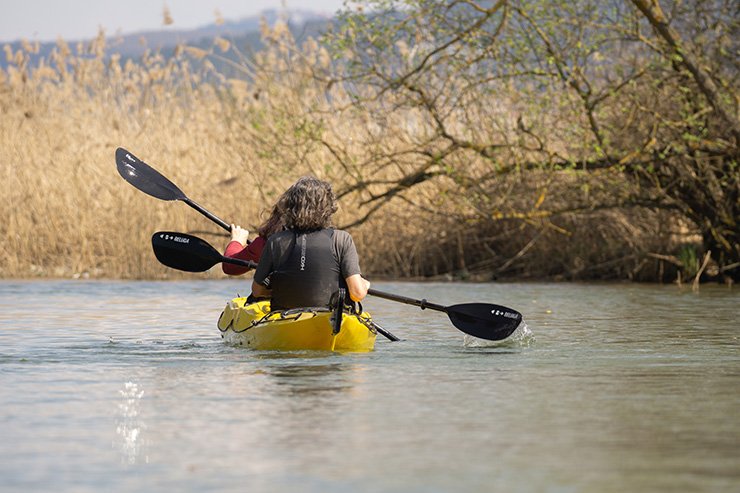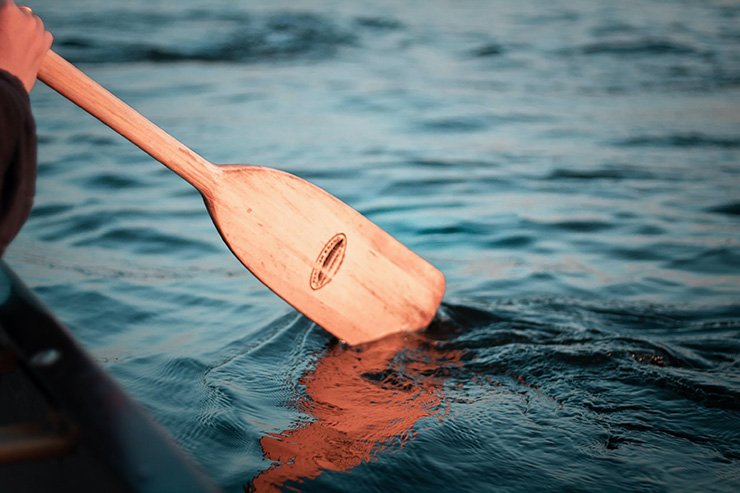Canoes and kayaks are similar in many ways, they’ve been around for centuries, and you need a paddle to propel them both. These vessels are used for the same things, like fishing, whitewater paddling, and touring.
However, they also have their differences, like the difference in paddles. You use a single-bladed paddle in canoeing, while in kayaking, you use a double-bladed paddle. Although the two paddles are visibly different, it’s easy to wonder whether you can use them interchangeably.
Can you canoe with a kayak paddle, for instance? Well, yes, you can. But is it a good idea? Canoe paddles and kayak paddles are different for a reason. So before you pick up a kayak paddle and head out, there are a few key things to note. And I discuss them all here.
RELATED: What are the Differences Between Kayaks and Canoes?
Key Takeaways
- A kayak paddle has two blades, while a canoe paddle has one blade. They also differ in shape, length, and material.
- A kayak paddle can be useful for solo canoeists who want to avoid switching sides and corrective strokes, which can be tiring and stressful for the wrists and shoulders.
- A kayak paddle can also help with speed and rough weather conditions, but it may cause paddle drip, wind resistance, and handling issues in narrow spaces.
- A canoe paddle can be used for kayaking, but it may not be very efficient or comfortable. It may also slow down the kayak and require more effort.
Can You Use a Kayak Paddle With a Canoe?
Yes, you can paddle a canoe with a kayak paddle. Using a single-blade canoe paddle makes the most sense for many canoeists. But many realize that using a kayak paddle has its benefits too, especially for solo paddlers.
In tandem canoeing, you have two paddlers, each paddling on either side. On a solo boat, it’s just you and your single-blade canoe paddle. Switching to a double-bladed paddle may be a wise decision for those solo canoe trips.
Before we get into the pros and cons of double-blade and single-blade paddles for canoeing, let’s take a look at their differences.
How Is a Kayak Paddle Different From a Canoe Paddle?

The most obvious difference is the blade. A canoe paddle only has one blade. You paddle on one side, and your partner paddles on the other to keep the canoe on a straight path. If you’re paddling solo, you’ll need to alternate sides more frequently.
Canoes have taller sides and tend to sit higher in the water, which calls for a more vertical stroke, with one hand on the T-grip and the other on the shaft.
A kayak paddle has two blades, one on either end. You hold the shaft with both hands and alternate paddling on both sides.
Another difference is in the shape of the paddle blade. Most kayak paddles tend to have an asymmetrical blade as this provides more power. A canoe paddle has a symmetrical blade.
Most canoe paddles are made of a single piece of wood. You can’t adjust the length. Kayak paddles are made of different materials, including aluminum and fiberglass. They are usually collapsible and adjustable. You can play around with different lengths to see what’s comfortable.
Paddling a Canoe with a Kayak Paddle

If you decide to try out a kayak paddle for canoeing, you’ll first need to get one that’s long enough. I have mentioned that canoes have higher sides compared to kayaks. A longer paddle lets you properly immerse the blade into the water without hitting the sides. It’s also much less awkward.
Pros of Using a Double-Blade Paddle in a Canoe
One of the main advantages of using a kayak paddle for a canoe is less stress on your wrists and shoulders.
When paddling a solo canoe using a traditional canoe paddle, you have to switch paddling sides, which can strain your shoulders. You also need to perform corrective strokes constantly, which may result in pain with time.
A kayak paddle has two blades, and so you’ll be paddling both sides, which eliminates the need for switching sides and corrective strokes.
This is easier on your wrists and shoulders. Plus, if you learn how to paddle properly with it, you’ll be using the much bigger muscles in your back and core for a paddle stroke and save your smaller muscles the stress.
Another advantage is that if you use a kayak paddle with your solo canoe, you’ll notice you can paddle faster with less effort.
When you encounter rough weather on your canoe trip, you’ll have an easier time with a kayak paddle. You can make quicker paddle strokes than you would with a single-blade paddle. You also don’t need to switch sides. Every stroke and every second counts when you’re up against strong waves or winds.
But using a double-blade paddle for your canoe is not all perfect, and there are downsides. One of them is that it just doesn’t handle as well as a single-blade paddle in small spaces.
Without the extra blade, a traditional canoe paddle is shorter and less bulky. It’s easier to use if you’re passing through a narrow space.
Another issue is paddle drip, where water from the blade that’s in the air drips onto you and into your canoe. This can be quite unpleasant, especially when canoeing in the colder months.
While having two blades means more paddling strokes and faster speed, the blade that’s out of the water can catch the wind, increasing resistance. You might find this annoying and even tiring, especially in windy conditions.
However, you can reduce resistance by feathering the paddle. This is where you have the blades at an angle to each other instead of flat. What it does is that the top blade will be slicing through the wind instead of catching it.
What Is the Right Kayak Paddle for a Canoe?

The paddle you typically use for your kayak may not be comfortable if you decide to use it for your canoe. Your kayak sits lower in the water, and so for a canoe, you’ll need a much longer paddle.
Factors to Consider When Choosing a Kayak Paddle for Your Canoe
The first factor that you should take into account is your height. This is key when you’re choosing a paddle for virtually any paddle craft.
Although you generally need a longer kayak paddle for canoeing, you shouldn’t pick the longest paddle you can find. If you are on the shorter side, you should go for a shorter paddle–just not as short as or shorter than what you typically use for kayaking.
On the other hand, taller paddlers will need a paddle longer than what they use for kayaking.
Another factor to consider is the size of the canoe. With a wide canoe, you want to get a paddle long enough to reach the water comfortably. A shorter paddle won’t work because you’ll lift your upper hand too high just to make a proper paddle stroke. This is tiring. You’ll also keep hitting the gunwales, much to your frustration.
You should be able to make a nice paddle stroke without straining, leaning towards one side, or struggling to handle the paddle.
Is a Kayak Paddle Better for Solo Canoeing?
When paddling a canoe with a partner, someone is paddling on either side. The canoe moves faster, straighter, and more efficiently.
But for solo canoeists, changing sides and making corrective strokes can be strenuous for your wrist and shoulders–more so if you already have a pre-existing condition.
Using a kayak paddle for a solo boat helps you go straighter without constant steering strokes.
It’s really a matter of personal preference, though, because even a kayak paddle has its downsides.
Some canoeists prefer to have both paddles–a single-blade paddle and a double-bladed paddle. This way, they can alternate depending on the situation. You can use your canoe paddle for tight spaces and your kayak paddle for relaxed cruising.
Can You Use a Canoe Paddle for Kayaking?

So we have established that you can use a kayak paddle for canoeing. But how about a canoe paddle for kayaking?
Yes, you can. But it might not be a smooth experience and you may not like the constant need to switch paddling sides. Kayaks are also narrower and you sit lower in the water. So while you need a longer kayak paddle for canoeing, you’ll need a shorter canoe paddle for kayaking.
There aren’t many advantages of kayaking using a canoe paddle. The biggest one is that you won’t have to worry about paddle drip. This, however, isn’t usually a big deal for kayakers.
A little drip when it’s hot won’t bother you. And if it’s cold you can dress appropriately. Besides, as a kayaker, you are always prepared for an unexpected swim anyway. You can also get paddle drip rings. They are rubber rings that you put on your shaft to catch the water and direct it away from you.
The other upside is that a canoe paddle is slightly less bulky. You don’t have the extra blade and shaft length. So a canoe paddle may be lighter and easier to carry.
As you can tell, the pros of using a canoe paddle for kayaking don’t really make a strong case. You’ll be forced to switch sides after each stroke to keep the kayak on a straight path. This will slow you down and tire you very quickly.
When you look at the benefits and downsides of a canoe paddle for kayaking, you’ll realize that you are better off using a proper kayak paddle.
Bottom Line
So, can you canoe with a kayak paddle? Yes, you can. Although traditional canoe paddles have one blade–for good reason–you might benefit from using a kayak paddle.
Most canoes are tandem canoes that two people paddle. While using a traditional canoe paddle, each paddler paddles on one side and this is efficient. But with solo canoes, there’s only one paddler with a single-bladed paddle. Having to switch sides often can be less efficient.
A kayak paddle, being double-bladed, means you don’t have to switch sides, and this is less tiring. It can also prevent your wrists from straining.
If you decide to use a kayak paddle for your solo canoe, get one that’s a little longer. You’ll be able to make proper paddle strokes without hitting the canoe gunwales.
Note that using a kayak paddle for canoeing has its downsides. It’s better to try one first and see if it works. Some solo canoeists prefer to use both a double and single-blade paddle.

